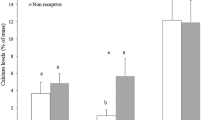Summary
-
1.
Following copulation, female Thamnophis radix are unattractive to sexually active males for at least 48 h; the stimulus basis for this change is the mating plug produced by secretion from the male's renal sex segment.
-
2.
The mating plug inhibits the courtship behavior of other, unmated males.
-
3.
The effect of mating and the mating plug on female sexual attractivity and receptivity serves to maximize a male's reproductive success by minimizing the probability of multiple inseminations.
-
4.
Loss of attractivity and mating-associated behavioral changes protect the female from subsequent courtships and copulations, thus minimizing predation dangers.
-
5.
Inhibition of other male's courtship behavior confers a reproductive advantage on the mating male; this odor may be the stimulus underlying unsuccessful male dispersal from mating balls.
Similar content being viewed by others
References
Adler, N.T.: The behavior control of reproductive physiology. In: Reproductive behavior. Montagna, W.A., Sadler, W.A. (eds.), pp. 259–286. New York: Plenum Press 1974
Aleksiuk, M.: Manitoba's fantastic snake pits. Natl. Geo. 1975, 715–725 (1975)
Aleksiuk, M., Gregory, P.T.: Regulation of seasonal mating behaviour in Thamnophis sirtalis parietalis. Copeia 1974, 681–688 (1947)
Aleksiuk, M., Stewart, K.W.: Seasonal changes in the body composition of the garter snake (Thamnophis sirtalis partietalis) at northern latitudes. Ecology 52, 485–490 (1971)
Alpin, R.T., Birch, M.C.: Pheromones from the abdominal brushes of male noctuid Lepidoptera. Nature 217, 1167–1168 (1968)
Asdell, S.A.: Patterns of mammalian reproduction. New York: Comstock Publishing Co. 1946
Beach, F.A.: Sexual attractivity, proceptivity and receptivity. Horm. Behav. 7, 105–138 (1976)
Blandau, R.J.: Is the copulation plug essential for the en masse transport of spermatozoa into the uterine cornua of the albino rat? Anat. Rec. 91, 266–267 (1945)
Burghardt, G.M.: Chemical perception in reptiles. Adv. Chemoreception 1, 241–308 (1970)
Carpenter, C.C.: Communication and displays of snakes. Am. Zool. 17, 217–224 (1977)
Crews, D.: Hormonal control of male courtship behavior and female attractivity in the garter snake (Thamnophis sirtalis). Horm. Behav. 7, 451–460 (1976)
Devine, M.C.: Copulatory plugs in snakes: Enforced chastity. Science 187, 844–845 (1975)
Devine, M.C.: Species discrimination in mate selection by free-living male garter snakes and experimental evidence for the role of pheromones. Herp. Rev. 7, 79 (1976)
Devine, M.C.: Copulatory plugs, restricting mating opportunities and reproductive competition among male garter snakes (Thamnophis). Nature 267, 234–346 (1977)
Eadie, W.R.: Corpora amylacea in the prostatic secretion and experiments on the formation of a copulatory plug in some insectivores. Anat. Rec. 102, 259–267 (1948)
Erickson, C.J., Zenone, P.G.: Courtship differences in male ring doves: Avoidance of cuckoldry? Science 192, 1353–1354 (1976)
Fitch, H.S.: An ecological study of the garter snake, Thamnophis sirtalis. Univ. Kans. Publ. Mus. Nat. Hist. 15, 493–564 (1965)
Gardner, J.B.: A ball of garter snakes. Copeia 1955, 310 (1955)
Gardner, J.B.: A garter snake ball. Copeia 1957, 48 (1957)
Gilbert, L.E.: Postmating female odor in Heloconius butterflies: A male-contributed anti-aphrodisiac? Science 193, 419–420 (1976)
Gregory, P.T.: Patterns of spring emergence of the red-sided garter snake (Thamnophis sirtalis parietalis) in the interlake region of Manitoba. Can. J. Zool. 52, 1063–1069 (1974)
Happ, G.M.: Multiple sex pheromones of the mealworm beetle, Tenebrio molitor L. Nature 222, 180–182 (1969)
Hawley, A.W.L., Aleksiuk, M.: Thermal regulation of spring mating behavior in the red-sided garter snake (Thamnophis sirtalis parietalis). Can. J. Zool. 53, (6), 768–776 (1975)
Hawley, A.W.L., Aleksiuk, M.: The influence of photoperiod and temperature on seasonal testicular recrudescence in the red-sided garter snake (Thamnophis sirtalis parietalis). Comp. Biochem. Physiol. 53, 215–221 (1976)
Joshi, M.S., Yaron, A., Linder, H.R.: Intrauterine gelation of seminal plasma components in the rat after coitus. J. Reprod. Fertil. 30, 27–37 (1972)
Kubie, J.L., Cohen, J., Halpern, M.: Shedding enhances the sevual attractiveness of oestradiol treated garter snakes and their untreated penmates. Anim. Behav. 26, 562–570 (1978a)
Kubie, J.L., Halpern, M.: Laboratory observations of trailing behavior in garter snakes. J. Comp. Physiol. Psychol. 89, 667–674 (1975)
Kubie, J.L., Halpern, M.: The chemical senses involved in garter snake prey trailing. Neurosci. Abst. 2, No. 209 (1976)
Kubie, J.L., Vagvolgi, A., Halpern, M.: The roles of the vomeronasal and olfactory systems in the courtship behavior of male garter snakes. J. Comp. Physiol. Psychol. (in press) (1978b)
Leopold, R.A.: The role of male accessory glands in insect reproduction. Ann. Rev. Entomol. 21, 199–221 (1976)
Martan, J., Shepard, B.A.: The role of the copulatory plug in reproduction of the guinea pig. J. Exp. Zool. 196, 79–84 (1976)
McGill, T.E.: Reproductive isolation, behavioral genetics, and functions of sexual behavior in rodents. In: Reproductive behavior and evolution. Rosenblatt, J.S., Komisaruk, B.R. (eds.), pp. 73–110, New York: Plenum Press 1977
Noble, G.K.: The sense organs involved in the courtship of Storeria Thamnophis and other snakes. Bull. Am. Mus. Nat. Hist. 73, 673–725 (1927)
Parker, G.A.: Sperm competition and its evolutionary consequences in the insects. Biol. Rev. 45, 525–567 (1970)
Pisani, G.R.: Comments on the courtship and mating mechanisms of Thamnophis (Reptilia, Serpentes, Colubridae). J. Herp. 10, 139–142 (1976)
Ross, P., Crews, D.: Influence of the seminal plug on mating behaviour in the garter snake. Nature 267, 344–345 (1977)
Stewart, G.R.: Some observations on the natural history of two Oregon garter snakes (genus Thamnophis). J. Herp. 2, 71–86 (1968)
Stockard, C.R., Papanicolaou, G.N.: The vaginal closure membrane copulation, and the vaginal plug in the guinea pig, with further considerations of the oestrous rhythm. Biol. Bull. 37, 222–245 (1919)
Thornhill, R.: Sexual selection and paternal investment in insects. Am. Natural. 110, 153–163 (1976)
Tinklepaugh, O.L.: Occurrence of a vaginal plug in a chimpanzee. Anat. Rec. 46, 329–332 (1930)
Wang, R.T., Kubie, J.L., Halpern, M.: Brevital sodium: An effective anesthetic agent for performing surgery on small reptiles. Copeia 1977, 738–743 (1977)
Author information
Authors and Affiliations
Rights and permissions
About this article
Cite this article
Ross, P., Crews, D. Stimuli influencing mating behavior in the garter snake, Thamnophis radix . Behav. Ecol. Sociobiol. 4, 133–142 (1978). https://doi.org/10.1007/BF00354976
Received:
Issue Date:
DOI: https://doi.org/10.1007/BF00354976




